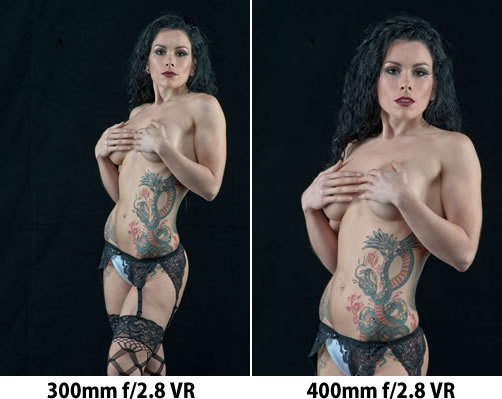
Home >>Test Configurations & Nikon Links
As I mentioned earlier, the sheer number of combinations that arose from testing three different camera sensors; the Nikon D3, the D3s and the D3X, four teleconverters; the Nikon TC-14E II, the TC-17E II, the TC-20E II and the latest TC-20E III and eight Nikon telephoto lenses; the Nikkor 70-200mm f/2.8 VR and VR II, the Nikkor 200-400mm f/4 VR, the Nikkor 200mm f/2 VR, the Nikkor 300mm f/2.8 VR, the Nikkor 400mm f/2.8 VR, the Nikkor 500mm f/4 VR and the Nikkor 600mm f/4 VR almost proved overwhelming. Adding to the workload, we also opted to shoot frames on the 200-400mm f/4 VR at 200mm, 300mm, and 400mm, which was a little like (indeed it was) adding two more lenses to our test. All in all, starting with the baseline shot of the camera and lens in question alone, with no teleconverter, we had some one hundred and fifty different combinations, and at two frames per set-up, three hundred shots in all.
We chose the D3, the D3s and the D3x because all three have different sensors, they are almost certainly the cameras being used by most Nikon professionals and -- we reasoned at the time -- are the cameras most likely to be paired by photographers with the cream of the premium glass available in the Nikon telephoto lens line-up. We had originally intended to add the D300's DX sensor to compare it with its FX big brothers, but an hour into the test we decided to slash 25% of our workload by dropping a camera and the DX format lost out. All of us had just finished doing an intensive three day photography seminar and the prospect of staying until three o'clock in the morning in the studio filled all of us with a certain amount of dread. As it was, we started early in the morning on Sunday and didn't leave the VPW studio until well after midnight.
As it was, we spent five and a half hours changing what seemed like an endless array of cameras on the Wimberley gimbal, with the attendant tension and stress created by handling tens and tens of thousands of dollars worth of camera bodies and lenses over the concrete floor of the studio. Even one drop might have been catastrophic and all of us were aware the fact. In the end, we all became very proficient at each of our assigned tasks, one of us handling the camera bodies and the cable release, another the lenses and a third the teleconverters. It really was like being on an assembly line. And the Nikon mounts require very controlled movements to engage and lock smoothly, which, when you take into account the weight of some of the big lenses we tested, was not always an easy task. We were also very cognizant of the fact that we didn't want to expose the sensors to the open air for any more time than we had to.
Long story short, early on in the test, someone, most probably myself, bumped the aperture setting on the D3s from f/11 to f/2.8 meaning that most of the shots we took were over-exposed. The fact that I was looking through the view-finder to check the focus on two frames for every set-up and STILL failed to notice this glitch still makes me go DOH! almost four months later.
The new D3s was actually one of the main reasons for us to do this side by side comparison test with the full array of Nikon FX camera bodies. Rick and Marc and I really wanted to see how the D3s sensor matched up against the D3, and we were all keen to compare the 70-200mm f/2.8 VR i and VR II versions against each other, as well as the new and old versions of the Nikon TC-20E, the II and the III.
During the Vancouver 2010 Winter Olympics I had used the new TC-20E III in combination with my Nikkor 300mm f/2.8 VR to shoot the bronze medal game between the United States and Finland, and had been so satisfied with the results that it had first planted the seed to do this test. And this was using the lens with my Nikon D3s on a monopod with the light in General Motors Place Arena. Olympic hockey players - at full speed! See an example image
Furthermore, Rick and I were both very curious to see how the TC-20E III would fare when mounted on the f/4 telephoto lenses. Nikon itself states very specifically that the TC-20E III is manufactured to work with the f/2.8 telephoto lenses, and indeed is not compatible with the f/4 telephotos, because the amount of light lost will not enable the lenses to autofocus. As you can see from the test shots, the conditions we used in the studio were actually quite arduous on the Nikon autofocus system; the studio was dark, the only light on our model, Marisa came from the modeling lights on the strobes and the shots were taken at f/11. And in fact, Nikon is right. Both the Nikkor 500mm f/4 and the Nikkor 600mm f/4 had great difficulty in auto-focusing with the TC-20E II and the TC-20 III, and in the end, we had to use manual focus on the 600mm f/4 to get the shot. But the results speak for themselves. Interestingly, depth of field was a much greater issue. Using the TC-20E on the 600mm -- even at f/11 -- means that even at sixty feet you have very little depth of field, less than six inches. So, if you're birding and want 1200mm worth of focal length, you'll really want to make sure that eye is in sharp focus! That and a superior tripod set-up, Wimberley head and sandbags. Any kind of wind would probably cause one no end of difficulties.
On the other hand, the 200-400mm VR, while it did hunt a little to find focus, did seem better able to utilize the light that was available. That actually surprised me. As for sharpness, it left a lot to be desired with the teleconverters.
Two lenses really stood out for me in the test when combined with the new TC-20E III, the new Nikkor 70-200mm f/2.8 VR II, and the Nikkor 400mm f/2.8 VR. Based on the results I obtained from this test, I was quite comfortable taking the new TC -- in concert with my new 70-200 f/2.8 VR II -- to Mexico and Cuba with me, in the event that I wanted to do some birding. I used the combination and I was extremely pleased with the results. And the 400mm f/2.8 VR? It is just a spectacular lens, and this was the first chance I had had to use one for an extended period of time, as we had it for the weekend. Even with the TC-20E teleconverters on, the lens stood out amongst its brethren, in its ability to focus.
This one shot made the entire undertaking worth the effort.I want one.
And as for my Nikkor 300mm f/2.8 VR -- the lens that had prompted this gear extravaganza in the first place? It didn't disappoint in the studio either, when used with the latest version of the TC-20E.
Conclusions. Well, Rick and I had already purchased the new TC-20E III, but if we hadn't, the results from our test would have been more than enough to convince us that it would make a valuable addition to our camera bags.
- Vince Hemingson
Recommended Nikon Gear Links
Nikon Photographers
Nikon Resources
Home >>Test Configurations & Nikon Links








